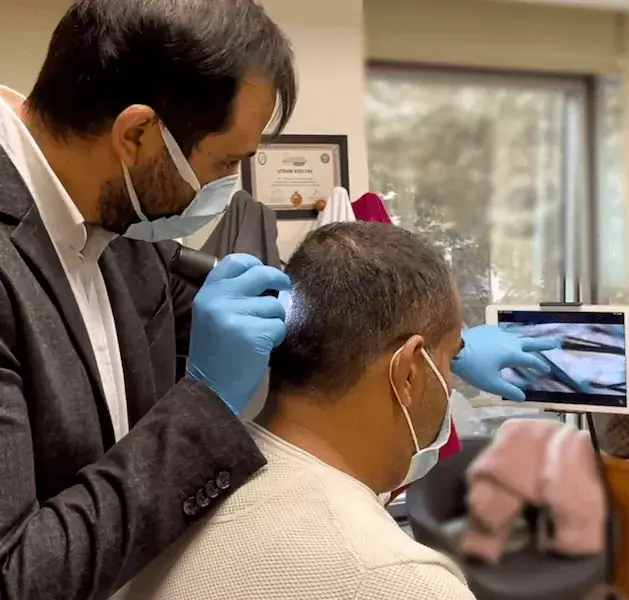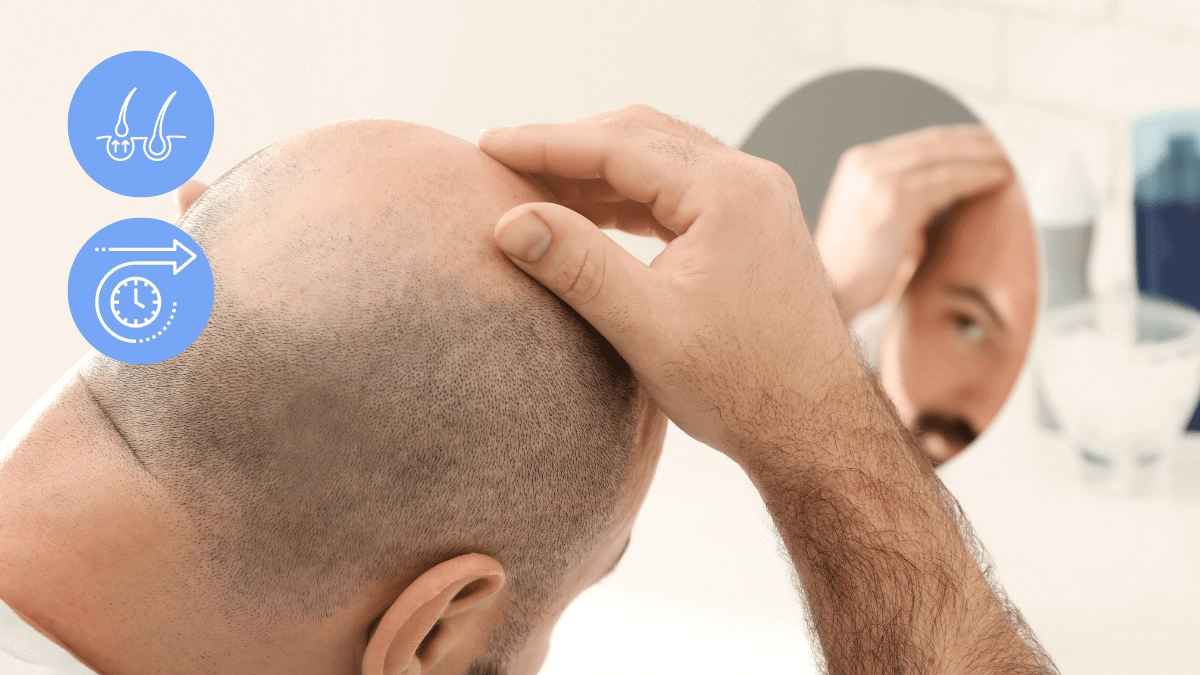TL;DR
➡ There is no definitive right age for getting a hair transplant. However, studies show that hair loss becomes visible by age 30.
➡ Depending on your studies, we have an ideal age gap starting from 25 that you have to fit in to know that it is your time to get a hair transplant.
➡ However, being eligible depends on factors other than fitting the age gap, such as having enough hair follicles on your head.
According to American Hair Loss Association, almost 66% of men will experience hair loss by age 35.
With how universally common hair loss is, every man who passes the age barrier of 20 eventually starts to worry and look out for any signs of baldness. Or at least, that is what you should do if you value your hair’s future health.
But simply seeing some parts of your scalp that have thinned hair is not enough to decide on getting a hair transplant.
So, what should you look for? When exactly is the right time or age to get a hair transplant? And what other reasons exist (if there are any) to decide on getting a hair transplant?
In this blog, I will go over these questions one by one and hopefully clear your concerns about deciding on your next move to guarantee your hair’s healthy future:
Table of Contents
Let’s start by getting the obvious question out of the way:
Is There a Right Age for Getting a Hair Transplant?
As the hair loss statistics indicate, by the age of 30, 25% of men have visible hair loss. That is why by many standards, the age gap between 25 to 35 is seen as where androgenetic alopecia and male pattern baldness start to display visible effects on the scalp hair, such as thinning and hairline receding. So, speaking of the statistics, we at least know that the first signs of hair loss can start as early as when a person is in their early twenties. However, this does not give us an actual age for when exactly hair loss begins in men, and, more importantly, it does not create a precise age that you should meet to determine whether you can get a hair transplant now.
So, no. There is no right age for getting a hair transplant.
Furthermore, even if there were one, this alone would not be enough indicator to say that you are currently eligible for getting a hair transplant simply because you have passed that age. Because there are still other conditions you must meet even if you are at a suitable age. Let me put it this way:
We know that hair loss starts can appear in small signs as early as in your twenties and only continue to become even more of an issue from then on. So, considering we have somewhat of an age gap instead of the exact age, we should not focus on determining the exact age. Instead, we should look for the conditions that decide whether you are eligible for a hair transplant.
So, let’s put away the questions about age and focus on the time and the conditions that determine it is the right time: Which conditions determine that right now you are eligible to get a hair transplant?
When Are You Eligible to Get a Hair Transplant?
⚠️ One common mistake a patient can make in a sudden decision is getting a hair transplant at the first sign of hair loss. Remember that hair transplants should be considered when an area in your scalp becomes bald, not when early ages of hair loss (that can be stopped and even reversed with many hair regrowth options) appear.
Usually, most patients from any background are suited for hair transplants. But, when we consider factors such as signs of hair loss appearing in your twenties, as I have mentioned earlier, we see that the right conditions that a patient has to meet to be a candidate for a hair transplant can be boiled down to three points:
- The number of hair follicles on your scalp: Hair transplants require follicles, so the number of hair follicles from the healthy areas you have in your head that are not affected by male pattern baldness will heavily influence the outcome. For best results, your donor area should be at least equal to the balding area.
- Staying within the ideal age gap: In some cases, we can guess that patient’s body will likely reject the hair transplant after the surgery based on biological factors such as age. As we said earlier, there is no definitive age you need to pass to be eligible. However, we can determine an age gap based on the universal success rates of patients and the hair regrowth process of your body that changes throughout your life. So, ideally, patients between the ages of 25-65 are best suited for this operation, as age strongly affects whether your hair is thick enough to survive the transplant.
- Having an advanced balding area on your scalp: A hair transplant is best suited for patients who show a clear sign of developed baldness rather than patients who are at the early ages of their hair loss. There are several signs to look for to understand whether your hair is balding, such as seeing your scalp in the mirror, changing hair lines, and losing more hair than usual every day.
💡Overall, aside from these factors, whether you are comfortable with getting surgery is a factor that we highly value as well. So, as we never tire of reminding this essential factor, it is always the safest option to talk to your doctor before making a decision.
Aside from necessary positive criteria, there are also negative conditions that show you are instead not eligible for a hair transplant, such as:
❗ Not having enough hair grafts on your scalp: Patients who do not have enough hair grafts that contain the required number of hair follicles to be harvested will meet difficulty in the surgery process. Due to the donor area being smaller than the balding area or a condition that actively destroys a patient’s hair follicles, such as scarring alopecia, your existing number of hair follicles will likely not be enough to cover up all the balding areas. In some hazardous cases, this might cause you to lose your existing hair follicles altogether, which is why you should always consult a clinic with an expert dermatologist at present beforehand.
❗ Not being the ideal age gap: In some instances, patients experience extreme shedding and hair loss in their youth before they even enter the ideal age gap, mostly due to excessive stress levels or genetic factors. So, they may be inclined to consider getting a hair transplant as soon as possible. However, this will only create long-term pressure on your scalp’s overall health. That is because patients who are outside the ideal age gap, especially those under the age of 25, as in those ages, experience balding in its early, evolving, and aggressive era. In these instances, it is best to ask your doctor whether to get a hair transplant right away or wait until the accelerated shedding phase slows down when you enter the age gap.
When all of these requirements are checked, we can see that the ideal answer to when a patient is eligible to get a hair transplant is after they have waited until the passing of age 25 and are sure they meet all the necessary conditions for being a candidate.
We accept that the process requires a bit of time to wait before deciding on surgery, and you may still have questions about how the transplantation process will go. So, it is natural to have concerns even if you think it is the right time for you. This is where we come in:
Do You Think It’s Time For You? 🩺

At UnitedCare, we begin your hair transplant process by offering you a one-on-one consultation with our expert doctors and dermatologists to find the best-suited option together. Our holistic approach provides you with a mix of the most advanced technologies and methods, such as DHI and Sapphire FUE, KE-Bot, and bio-enhancements, to ensure that you do not need another surgery.
In your consultation, our expert doctors check your scalp’s health and medical background to decide which method is the most suited for you and, more importantly, if it is the right time for you to get a hair transplant. After you have decided on a method, we begin the treatment with the utmost attention. But most importantly, we stay in contact with our patients even long after the treatment has already finished ensuring that the surgery succeeds in becoming a permanent one.
If you believe it is the right time to search for the right method to bring back your shining hair to its deserving place, you can schedule a free call immediately. Regardless of which option you choose, one policy in our clinic stays the same. We value creating a balance between your comfort and your health.
Ready to begin the journey? Click here to start the first step:
It is time that your hair returns to its great looks.
UnitedCare’s expert dermatologists are here to give you a free consultation on your process:
Frequently Asked Questions (FAQs)
Is it better to get a hair transplant sooner?
It depends on your situation regarding the number of hair follicles left on your scalp and how much the balding areas progressed. Ideally, we want our patients to wait until they enter the ideal age gap between the ages of 25 to 65. However, there are instances when patients experience advanced levels of balding and shedding due to factors such as extreme stress or genetic factors. After consulting your doctor regarding your current situation, they might decide that getting a hair transplant is better than waiting for the age gap to arrive. That way, you can ensure the survival of your hair’s great outlook before your existing balding advances too far. But suppose there are only minor signs of hair loss marking its beginning. In that case, it is better to look for alternative hair loss methods that are most suited for less advanced hair loss cases (and can even reverse the hair loss entirely) with the help of your doctor.
Is 27 too early for a hair transplant?
Objectively speaking, 27 is not too early for a hair transplant as it suits the ideal age gap of 25 to 65 for an effective hair transplant experience. However, this age gap is based on the effectiveness of universal hair transplant surgeries based on patients divided by their age, which defines effectiveness and success based on how many hair grafts survive after surgery. So, your personal experience, medical background, and the current state of your scalp with the remaining number of follicles on it and the width of the balding areas can very much change this answer. Suppose you have only started experiencing hair loss with minor hair shedding and some visible parts leaving empty spots on your scalp. In that case, it might be a little too early for a hair transplant, so your doctor might offer an alternative method for reversing hair loss. However, it might even be too late if you have been gradually experiencing advancing hair loss since you entered your twenties. In either case, our clinic’s motto is that you should get a consultation with a doctor immediately.
At what stage is hair transplant your best option?
Ideally, having advanced balding on your scalp is a definitive and legitimate reason for a hair transplant to be your best option. Since hair transplants work by transferring hair follicles from a healthy part of your scalp to another bald part, hair transplants must be considered before the bald areas in your head take up more space than the healthy ones. So, the stage for when a hair transplant becomes the best option is placed in the time between having a clear sign of developed baldness to experiencing the complete loss of hair follicles in your scalp. The only vital part you should pay attention to is continuously tracking how much your hair loss progresses. Because if it is at a very early age, by the time you notice, your doctor can provide you with medication to reverse the hair loss entirely instead of suggesting surgery. Our final advice is to get a consultation from your doctor.

